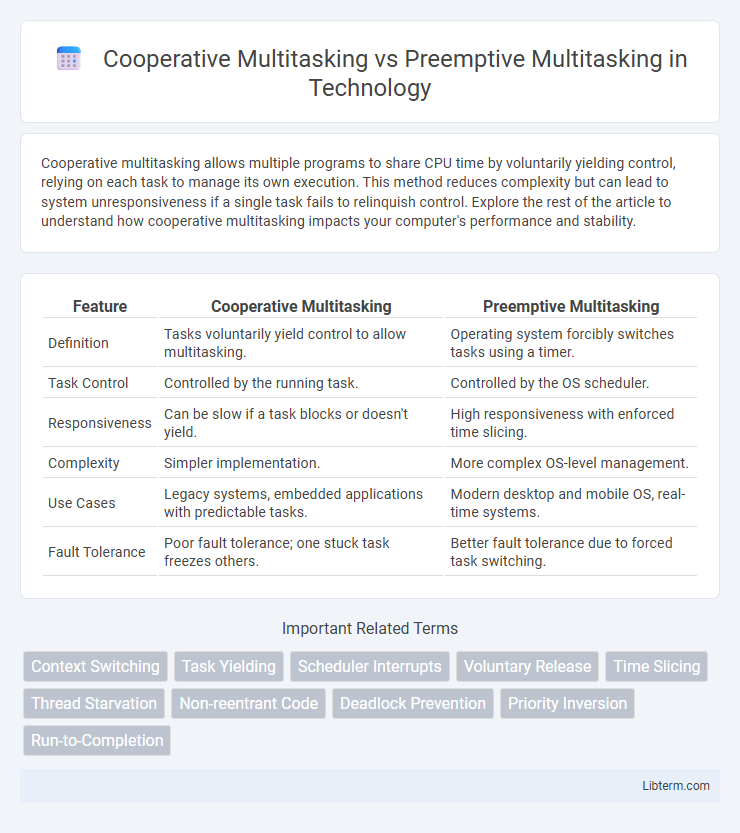Cooperative multitasking allows multiple programs to share CPU time by voluntarily yielding control, relying on each task to manage its own execution. This method reduces complexity but can lead to system unresponsiveness if a single task fails to relinquish control. Explore the rest of the article to understand how cooperative multitasking impacts your computer's performance and stability.
Table of Comparison
| Feature | Cooperative Multitasking | Preemptive Multitasking |
|---|---|---|
| Definition | Tasks voluntarily yield control to allow multitasking. | Operating system forcibly switches tasks using a timer. |
| Task Control | Controlled by the running task. | Controlled by the OS scheduler. |
| Responsiveness | Can be slow if a task blocks or doesn't yield. | High responsiveness with enforced time slicing. |
| Complexity | Simpler implementation. | More complex OS-level management. |
| Use Cases | Legacy systems, embedded applications with predictable tasks. | Modern desktop and mobile OS, real-time systems. |
| Fault Tolerance | Poor fault tolerance; one stuck task freezes others. | Better fault tolerance due to forced task switching. |
Introduction to Multitasking in Operating Systems
Multitasking in operating systems enables multiple processes to share CPU time efficiently, improving system responsiveness and resource utilization. Cooperative multitasking relies on each process to yield control voluntarily, which can lead to issues if a process fails to release the CPU. Preemptive multitasking uses the operating system's scheduler to forcibly allocate CPU time slices, ensuring fair resource distribution and preventing any single process from monopolizing the processor.
What is Cooperative Multitasking?
Cooperative multitasking is a CPU scheduling method where each running process voluntarily yields control to allow other processes to execute, relying on tasks to cooperate for smooth operation. This approach can lead to inefficiencies or system freezes if a process fails to relinquish control, as the operating system cannot forcibly interrupt running tasks. It is commonly used in older operating systems like classic Mac OS and early versions of Windows, where processes are responsible for managing their own execution time.
What is Preemptive Multitasking?
Preemptive multitasking is a CPU scheduling method where the operating system allocates CPU time slices to each running process and forcibly interrupts it to switch to another process, ensuring fair resource distribution and responsiveness. This approach enhances system stability by preventing any single process from monopolizing the CPU, allowing real-time applications and multitasking environments to function smoothly. Preemptive multitasking is widely used in modern operating systems like Windows, Linux, and macOS to improve overall system efficiency and user experience.
Core Differences Between Cooperative and Preemptive Multitasking
Cooperative multitasking relies on each process to voluntarily yield control of the CPU, making it simpler but vulnerable to unresponsive tasks that can freeze the system, while preemptive multitasking uses a scheduler to forcibly switch between tasks at regular intervals, enhancing system responsiveness and robustness. In cooperative multitasking, resource management is less complex but can lead to inefficiency if a process monopolizes CPU time; preemptive multitasking ensures fair CPU allocation among processes, preventing single tasks from dominating execution time. The core difference lies in control over task switching: cooperative multitasking depends on process cooperation, whereas preemptive multitasking enforces context switches through the operating system's intervention.
Advantages of Cooperative Multitasking
Cooperative multitasking offers precise control over task switching, allowing each process to run until it voluntarily yields control, which prevents race conditions and data corruption. It requires less overhead since the operating system does not need complex context-switching mechanisms, resulting in better performance on low-resource systems. This method simplifies programming models by avoiding the complexities of interrupt handling and synchronization issues inherent in preemptive multitasking.
Drawbacks of Cooperative Multitasking
Cooperative multitasking suffers from significant drawbacks, including the risk of a single task monopolizing CPU resources by failing to yield control, which can lead to system unresponsiveness or hangs. This reliance on each task's cooperation reduces overall system stability and responsiveness, especially in environments with multiple demanding applications. Furthermore, debugging and managing cooperative systems are more complex due to unpredictable task behaviors and the lack of enforced context switching.
Advantages of Preemptive Multitasking
Preemptive multitasking enhances system responsiveness by allowing the operating system to control CPU allocation, preventing any single process from monopolizing resources. This approach improves multitasking efficiency, enabling better performance in environments with numerous concurrent applications or processes. Its ability to interrupt and prioritize tasks reduces the risk of unresponsive or frozen programs, boosting overall system stability and user experience.
Drawbacks of Preemptive Multitasking
Preemptive multitasking can lead to complex synchronization issues due to its forced context switching, increasing the risk of race conditions and deadlocks in concurrent programs. The overhead of frequent task switching can degrade system performance, especially in systems with limited processing power. Moreover, it may cause responsiveness problems if high-priority tasks monopolize CPU time, leading to starvation of lower-priority processes.
Use Cases and Real-World Applications
Cooperative multitasking is ideal for simple embedded systems and legacy applications where tasks are predictable and require minimal interruption, such as in microcontrollers and early Mac OS environments. Preemptive multitasking suits modern operating systems like Windows, Linux, and Android, enabling efficient resource allocation across complex applications like web servers, video editing software, and multitasking smartphones. Real-world applications favor preemptive multitasking for responsiveness and stability in diverse workloads, while cooperative multitasking persists in resource-constrained or specialized environments with controlled execution flows.
Choosing the Right Multitasking Model for Your Needs
Choosing the right multitasking model depends on system requirements and application needs; cooperative multitasking is suitable for simpler environments where tasks yield control voluntarily, minimizing context-switching overhead. Preemptive multitasking, widely used in modern operating systems like Windows and Linux, ensures better responsiveness and stability by allowing the scheduler to interrupt tasks, essential for real-time and multitasking-heavy applications. Evaluating factors such as system complexity, real-time processing demands, and resource management helps determine whether cooperative or preemptive multitasking best aligns with your performance and reliability goals.
Cooperative Multitasking Infographic

 libterm.com
libterm.com